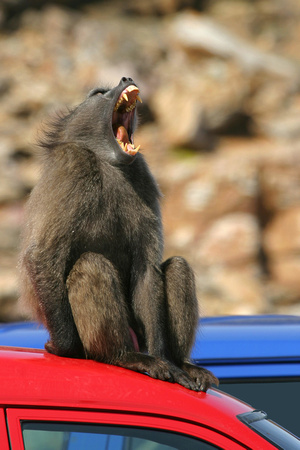Chacma Baboon, male (Bobbejaan) (Papio ursinus)
The Chacma Baboon (Papio ursinus), also known as the Cape Baboon, is, like all other baboons, from the Old World monkeyfamily. With a body length of up to 115 cm and a weight from 15 to 31kg, it is among the largest and heaviest baboon species. The Chacma isgenerally dark brown to gray in color, with a patch of rough hair onthe nape of its neck. Unlike the northern baboon species (the Guinea,Hamadryas, and Olive Baboons), Chacma males do not have a mane. Perhapsthe most distinctive feature of this baboon is its long,downwardly-pointed face.Males can have canine teeth as long as 2 inches (longer than a lion'scanine teeth). Baboons are sexually dimorphic, males being considerablylarger than females.
The Chacma Baboon is found in southernAfrica, ranging from South Africa north toAngola, Zambia, and Mozambique. Size and color vary within that range. The Cape Chacma (P. ursinus ursinus) from southern South Africa is a large, heavy, dark brown baboon with black feet. Another subspecies, the Gray-footed Chacma (P. u. griseipes),is present from northern South Africa to southern Zambia. It isslightly smaller than the Cape Chacma, lighter in color and build, andhas gray feet. The Ruacana Chacma (P. u. ruacana) is found inNamibia and southern Angola, and generally appears to be a smaller,less darkly colored version of the Cape Chacma.
Chacmas usually live in social groups composed of multiple adult males,adult females, and their offspring. Occasionally, however, very smallgroups form that include only a single adult male and several adultfemales. Chacma troops are characterized by a dominance hierarchy. Femaleranking within the troop is inherited through the mother and remainsquite fixed, while male ranking is tenuous and changes often. Chacmasare unusual among baboons in that neither males nor females form strongrelationships with members of the same sex. Instead, the strongestsocial bonds are often between unrelated adult males and females.Infanticide is also relatively common compared to other baboonsspecies, as newly dominant males will often attempt to kill youngbaboons sired by the previously dominant male.Baboon troops possess a complex group behavior and communicate by meansof body attitudes, facial expressions, sounds/calls and touch.
Chacmas inhabit a wide array of habitats, from the grassy alpine slopesof the Drakensberge to the Kalahari desert. The Chacma Baboon isomnivorous with a preference for fruits, while also eating insects,seeds and smaller vertebrate animals. The Chacma Baboon is generally ascavenger when it comes to game meat and rarely engages in huntinglarge animals. There has been one incident where a Chacma Baboon haskilled an infant, however the event is so rare the locals believed itwas due to witchcraft.Normally, a Chacma Baboon will not approach humans and/or have muchinterest in them. This has been changing due to the number of touristswho feed baboons, thereby teaching them that humans are a source of food.
The Chacma Baboon is widespread and does not rank among threatenedanimal species. However, in some confined locations such as SouthAfrica's Southern Cape Peninsula, local populations are dwindling dueto habitat loss. Some troops have become a suburban mennace,overturning trash cans and entering houses in their search for food.These animals can be aggressive and dangerous, such negative encountershave resulted in frustrated local


